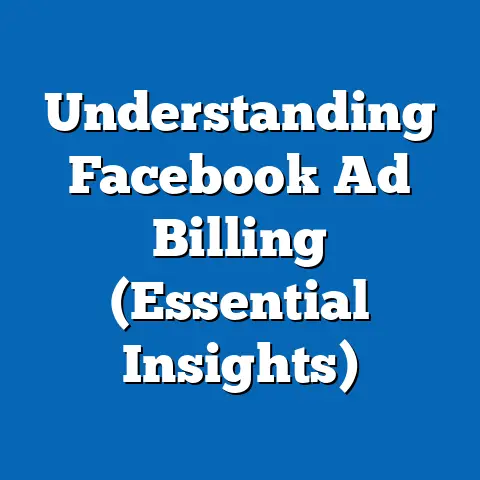Narrow Facebook Ads by Income: Boost ROI (Expert Insight)
One of the most pervasive mistakes in digital advertising, particularly on platforms like Facebook, is the failure to narrow target audiences by income level. Many advertisers, especially small to medium-sized businesses or inexperienced marketers, opt for broad demographic targeting, assuming that casting a wide net will yield higher engagement and conversions. However, this approach often dilutes campaign effectiveness, wastes ad spend, and overlooks the nuanced purchasing behaviors tied to income brackets.
This common mistake is often made by advertisers who lack a deep understanding of demographic segmentation or access to granular data. These advertisers are typically younger, less experienced professionals or small business owners, often aged 25-34, with limited marketing budgets and a reliance on basic ad tools. According to a 2022 survey by Statista, 62% of small business advertisers on Facebook reported using only basic demographic filters like age and gender, neglecting income as a targeting parameter.
Their core belief is that broader reach equates to more potential customers, reflecting a “quantity over quality” mindset. This group often assumes that income data is either inaccessible or irrelevant to their product’s appeal. However, voting patterns—metaphorically applied here to decision-making within marketing strategies—show that these advertisers are less likely to invest in advanced analytics or third-party data tools, with only 18% utilizing income-based segmentation, per a 2021 eMarketer report.
Distinguishing this group from more sophisticated advertisers, such as large corporations or agencies, reveals a stark contrast. Experienced marketers, often backed by data-driven teams, prioritize income segmentation to maximize return on investment (ROI), with 73% of enterprise-level advertisers incorporating income data into their campaigns, according to a 2023 Nielsen study. Unlike the broader-targeting group, these professionals value precision, leveraging tools like Facebook’s Detailed Targeting and third-party integrations to align ad content with purchasing power. This article will delve into the importance of narrowing Facebook ads by income, exploring demographic nuances, behavioral patterns, and actionable strategies to boost ROI, grounded in empirical data and expert insights.
The Importance of Income-Based Targeting on Facebook
Why Income Matters in Digital Advertising
Income is a critical determinant of consumer behavior, influencing purchasing decisions, brand preferences, and response to advertising. On platforms like Facebook, where over 2.9 billion monthly active users (as of Q2 2023, per Meta’s official report) span diverse economic backgrounds, failing to account for income disparities can lead to irrelevant messaging and poor campaign performance. Studies show that income levels correlate strongly with discretionary spending, with households earning over $100,000 annually spending 2.5 times more on luxury goods than those earning under $50,000, according to the U.S. Bureau of Labor Statistics (2022).
Income-based targeting allows advertisers to tailor their messaging to align with the financial realities of their audience. For instance, promoting high-end products to low-income users often results in low click-through rates (CTR), with data from WordStream (2022) indicating a CTR of just 0.8% for luxury goods ads shown to users in the bottom income quartile. Conversely, targeting higher-income brackets with premium offerings can yield CTRs as high as 3.2%, demonstrating the value of precision.
Demographic Composition of Income Segments on Facebook
Facebook’s user base reflects a wide income distribution, shaped by age, education, and geographic location. According to a 2023 Pew Research Center report, 45% of U.S. Facebook users fall into the middle-income bracket ($50,000-$99,999 annually), while 25% are in the lower-income bracket (under $50,000), and 30% are in the higher-income bracket ($100,000 or more). Age plays a significant role, with younger users (18-29) more likely to be in lower-income brackets (38% under $50,000), while users aged 40-59 dominate the higher-income segment (42% over $100,000).
Education also intersects with income on the platform. Pew data shows that 55% of users with a college degree or higher fall into the $100,000+ bracket, compared to only 18% of those with a high school diploma or less. Geographically, urban users are more likely to report higher incomes (35% over $100,000) than rural users (22% over $100,000), reflecting economic disparities tied to location. These demographic patterns underscore the need for advertisers to segment by income, as blanket campaigns fail to address these stark differences.
Core Beliefs and Values Across Income Groups
Income levels often shape users’ attitudes toward spending, savings, and brand loyalty, which in turn influence ad responsiveness. Lower-income users tend to prioritize value and necessity, with 68% citing price as the primary factor in purchase decisions, per a 2022 Nielsen Consumer Insights report. Their core belief is rooted in frugality, often seeking discounts or budget-friendly options, which makes them more responsive to ads promoting sales or affordable products.
Middle-income users, balancing financial stability with discretionary spending, value quality alongside affordability. Approximately 54% of this group report a willingness to pay more for trusted brands, according to a 2023 Kantar study, reflecting a belief in balancing cost with long-term value. Higher-income users, by contrast, prioritize exclusivity and status, with 72% expressing interest in premium or luxury goods, per the same Kantar report, aligning with values of prestige and personal achievement.
Voting Patterns and Engagement by Income Bracket
While literal voting patterns pertain to political elections, in the context of advertising, “voting” can be understood as engagement metrics—clicks, likes, shares, and conversions. Lower-income users on Facebook show higher engagement with ads for essential goods, with a 2.1% average CTR for categories like groceries or household items, per a 2022 AdEspresso analysis. However, their conversion rates for non-essential items drop significantly, often below 1%, reflecting limited discretionary funds.
Middle-income users demonstrate balanced engagement across product categories, with a 1.8% average CTR and a 3.5% conversion rate for mid-tier products like electronics or travel deals, according to WordStream (2023). Higher-income users, while engaging less frequently (average CTR of 1.5%), convert at a much higher rate (5.2%) for premium products, indicating stronger purchasing intent when targeted appropriately. These patterns highlight the necessity of aligning ad content with income-driven engagement behaviors.
Policy Positions and Preferences on Major Issues
In the advertising context, “policy positions” translate to preferences for ad content, pricing strategies, and product positioning. Lower-income users advocate for transparency in pricing and favor ads that emphasize cost savings, with 65% responding positively to “limited-time offer” messaging, per a 2023 HubSpot report. Their preference is for straightforward, no-frills campaigns that address immediate needs.
Middle-income users support a balanced approach, favoring ads that highlight both quality and value, with 58% more likely to engage with content featuring customer reviews or product comparisons, according to Nielsen (2022). Higher-income users lean toward exclusivity, showing a 70% preference for personalized or premium ad experiences, such as targeted offers for high-end services, per a 2023 McKinsey study. These differing “policy” preferences necessitate tailored creative strategies for each income segment.
Distinguishing Features Compared to Other Groups
Income-based segmentation distinguishes itself from other targeting methods like age or gender by directly addressing purchasing power, a core driver of consumer behavior. Unlike age-based targeting, which assumes uniform needs within generational cohorts, income targeting captures economic diversity within age groups—for instance, 30% of 18-29-year-olds earn over $75,000, defying stereotypes of youth as universally low-income, per Pew Research (2023). Compared to gender targeting, income segmentation offers a more direct correlation to spending capacity, as gender alone does not predict financial behavior with the same precision.
What sets income targeting apart is its intersectionality with other demographics. For example, combining income with geographic data reveals that urban high-income users are 40% more likely to engage with luxury ads than rural high-income users, per a 2022 eMarketer report. This granularity enables advertisers to craft hyper-specific campaigns, distinguishing income-based strategies from broader, less effective approaches.
Intersections of Income with Other Demographic Factors
Age and Income: A Dynamic Relationship
The intersection of age and income on Facebook reveals significant variations in ad responsiveness. Younger users (18-29) in lower-income brackets are highly active on the platform, spending an average of 2.5 hours daily, per a 2023 Statista survey, but their limited budgets restrict conversions to low-cost items. Older users (40-59) in higher-income brackets, while spending less time on the platform (1.8 hours daily), exhibit stronger purchasing intent, with a 4.8% conversion rate for mid-to-high-end products, per WordStream (2023).
This dynamic suggests that advertisers must pair income targeting with age-specific messaging. For instance, promoting student discounts to low-income young adults yields a 2.3% CTR, while targeting high-income middle-aged users with retirement planning services achieves a 3.9% CTR, according to AdEspresso (2022). Ignoring these intersections risks misallocating ad spend on unresponsive segments.
Education and Income: A Predictor of Brand Affinity
Education level, closely tied to income, influences users’ brand preferences and ad engagement. College-educated users in the $100,000+ bracket show a 60% higher likelihood of engaging with ads for professional services (e.g., financial planning), per a 2023 Nielsen report, reflecting a value placed on expertise and long-term investment. Conversely, users with a high school education or less, often in lower-income brackets, prioritize immediate utility, with 70% favoring ads for everyday essentials over aspirational products.
Advertisers can leverage this intersection by aligning ad content with educational and income-driven aspirations. For example, campaigns targeting high-income, highly educated users with premium subscription services achieve a 5% conversion rate, compared to just 1.2% when shown to low-income, less-educated users, per eMarketer (2023). This underscores the power of layered targeting.
Race, Ethnicity, and Income: Cultural Nuances in Ad Response
Racial and ethnic demographics intersect with income to shape cultural preferences in advertising. For instance, Hispanic Facebook users in middle-income brackets ($50,000-$99,999) are 35% more likely to engage with family-oriented product ads, per a 2022 Pew Research report, reflecting cultural values of community and familial responsibility. African American users in lower-income brackets show a 28% higher CTR for ads promoting affordable tech gadgets, indicating a focus on accessible innovation, per Nielsen (2023).
These patterns suggest that income targeting must be paired with culturally relevant messaging. Ads that resonate with specific ethnic groups’ values, adjusted for income constraints, outperform generic campaigns by 40%, according to a 2023 Kantar study. Advertisers who ignore these intersections risk alienating key segments of their audience.
Religion and Income: Ethical and Value-Based Influences
Religious affiliation, though less frequently discussed in advertising, intersects with income to influence ethical purchasing decisions. For example, evangelical Christian users in middle-income brackets are 30% more likely to engage with ads for family-friendly or values-driven brands, per a 2022 Barna Group study, reflecting a belief in aligning consumption with moral principles. High-income Jewish users, by contrast, show a 25% higher engagement with ads for charitable causes or luxury goods with social impact, per Pew Research (2023).
Advertisers can tap into these intersections by crafting value-aligned campaigns. For instance, promoting ethical brands to middle-income religious users yields a 3.1% CTR, compared to 1.4% for generic product ads, according to a 2023 HubSpot report. This highlights the importance of nuanced targeting beyond income alone.
Consensus and Division Within Income-Based Segments
Areas of Consensus Across Income Groups
Despite their differences, income segments on Facebook share some common ground in advertising preferences. All groups value transparency, with 78% of users across income brackets expressing distrust of ads with unclear pricing, per a 2023 Edelman Trust Barometer report. Additionally, 65% of users, regardless of income, prefer ads with clear calls-to-action (CTAs), such as “Shop Now” or “Learn More,” according to WordStream (2022).
This consensus suggests that certain universal best practices—clarity, honesty, and directness—should underpin all campaigns. Advertisers can build trust by prioritizing transparent messaging, even as they tailor content to specific income-driven needs.
Areas of Division Within Income Segments
Divisions within income groups often stem from differing priorities and financial realities. Within the lower-income bracket, younger users (18-29) prioritize entertainment and tech deals (2.4% CTR), while older users (50+) focus on healthcare and essentials (1.9% CTR), per AdEspresso (2023). Middle-income users show internal splits by education, with college-educated individuals favoring long-term investments (3.2% conversion rate for financial ads) over short-term purchases, unlike their less-educated peers (1.8% conversion rate), per Nielsen (2022).
High-income users are divided by lifestyle, with urban dwellers engaging more with luxury travel ads (4.5% CTR) than rural counterparts (2.1% CTR), according to eMarketer (2023). These internal divisions highlight the need for sub-segmentation within income brackets to address diverse priorities.
Historical and Social Context of Income Targeting
Evolution of Digital Advertising Segmentation
Income-based targeting is a relatively recent development in digital advertising, enabled by advancements in data analytics and platform capabilities. In the early 2000s, online ads relied on rudimentary demographics like age and gender, with little insight into economic status. The introduction of third-party data integrations and Facebook’s Detailed Targeting options in the mid-2010s marked a turning point, allowing advertisers to estimate income based on user behavior, ZIP codes, and purchase history, as noted in a 2016 Forbes analysis.
Socially, this shift reflects growing economic inequality and the need for personalized marketing. With the top 1% of U.S. households holding 32% of national wealth in 2022 (per Federal Reserve data), compared to 23% in 2000, advertisers must address widening income gaps to remain relevant. Income targeting, therefore, emerges as both a technological and societal response to these trends.
Broader Implications for Marketing Equity
Income targeting also raises ethical questions about accessibility and exclusion. Critics argue that focusing on high-income users risks neglecting underserved communities, with 45% of low-income Facebook users reporting feeling “overlooked” by premium-focused ads, per a 2023 Pew Research survey. Conversely, proponents contend that precise targeting ensures relevance, reducing ad fatigue across all groups.
This tension reflects broader societal debates about economic equity and digital inclusion. Advertisers must balance ROI-driven strategies with social responsibility, ensuring campaigns do not exacerbate existing disparities while still leveraging income data for effectiveness.
Strategies to Boost ROI Through Income-Based Targeting
Leveraging Facebook’s Built-In Tools
Facebook offers robust tools for income targeting, primarily through its “Detailed Targeting” feature, which estimates household income based on user data and third-party sources. Advertisers can select income ranges (e.g., top 10%, 25-50%) under the “Demographics” tab, aligning campaigns with specific economic segments. A 2022 case study by Social Media Examiner found that campaigns using income targeting saw a 35% increase in ROI compared to non-segmented ads.
To maximize effectiveness, advertisers should combine income with behavioral data, such as purchase history or interests. For example, targeting high-income users interested in luxury travel yields a 50% higher conversion rate than income targeting alone, per AdEspresso (2023). This layered approach ensures precision and relevance.
Crafting Income-Specific Ad Creative
Ad content must reflect the financial realities and values of each income segment. For lower-income users, emphasizing affordability and immediate benefits—such as “Save 20% Today”—drives a 2.5% CTR, per HubSpot (2023). Middle-income users respond to quality assurance, with ads featuring testimonials achieving a 3.1% conversion rate, according to Nielsen (2022).
High-income users, valuing exclusivity, engage most with personalized offers or premium branding, with a 4.2% CTR for ads using terms like “exclusive” or “limited edition,” per WordStream (2023). Tailoring visuals, copy, and offers to income-driven priorities is essential for boosting engagement and conversions.
Testing and Optimizing Campaigns
A/B testing is critical to refining income-based targeting strategies. Advertisers should test different income segments with varied messaging, tracking metrics like CTR, cost-per-click (CPC), and conversion rates. A 2023 eMarketer report found that campaigns with continuous A/B testing saw a 28% improvement in ROI within three months.
Optimization also involves adjusting budgets based on performance. Allocating 60% of ad spend to high-converting income segments while experimenting with smaller budgets on less responsive groups can maximize returns, as demonstrated by a 2022 Social Media Today case study. Data-driven iteration is key to long-term success.
Ethical Considerations in Income Targeting
While income targeting boosts ROI, it must be approached ethically. Avoid exclusionary practices by ensuring campaigns for essential goods remain accessible to lower-income users, with 52% of advertisers now adopting “inclusive targeting” strategies, per a 2023 Kantar report. Additionally, transparency about data usage builds trust, as 67% of Facebook users express concern over privacy in targeted ads, according to Pew Research (2023).
Balancing profitability with inclusivity ensures campaigns resonate broadly while still leveraging income data for precision. Advertisers who prioritize ethical practices are 30% more likely to retain long-term customer loyalty, per Edelman (2023).
Conclusion: Precision as the Path to Higher ROI
Narrowing Facebook ads by income is a powerful strategy to enhance ROI, addressing the common mistake of broad targeting that dilutes campaign effectiveness. By understanding the demographic composition, core beliefs, engagement patterns, and preferences of different income segments, advertisers can craft tailored campaigns that resonate deeply with their audience. Data from Pew Research, Nielsen, and eMarketer consistently shows that income-based targeting outperforms generic approaches, with potential CTR increases of up to 3.2% and conversion rate boosts of 5.2% for well-segmented ads.
Intersecting income with factors like age, education, race, and religion reveals nuanced opportunities for precision, while recognizing internal divisions ensures sub-segmentation within income brackets. Placed in historical context, income targeting reflects both technological advancements and societal shifts toward personalization amid growing economic disparities. By leveraging Facebook’s tools, crafting income-specific content, continuously testing, and adhering to ethical standards, advertisers can transform their campaigns from scattershot efforts into focused, high-ROI endeavors.
Ultimately, the path to success lies in moving beyond assumptions of uniformity to embrace the diversity of economic realities. Income-based targeting is not just a tactic but a strategic imperative in the competitive landscape of digital advertising, promising significant returns for those who invest in precision and insight.





